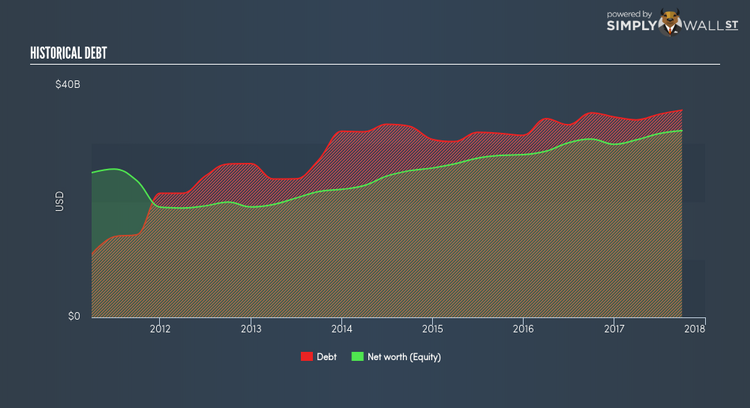Does Amgen Inc’s (NASDAQ:AMGN) Debt Level Pose A Problem?

Amgen Inc (NASDAQ:AMGN), a large-cap worth $134.32B, comes to mind for investors seeking a strong and reliable stock investment. Risk-averse investors who are attracted to diversified streams of revenue and strong capital returns tend to seek out these large companies. However, the key to extending previous success is in the health of the company’s financials. Let’s take a look at Amgen’s leverage and assess its financial strength to get an idea of their ability to fund strategic acquisitions and grow through cyclical pressures. Note that this information is centred entirely on financial health and is a high-level overview, so I encourage you to look further into AMGN here. See our latest analysis for Amgen
How much cash does AMGN generate through its operations?
AMGN has built up its total debt levels in the last twelve months, from $31,429.0M to $34,596.0M , which is made up of current and long term debt. With this growth in debt, AMGN currently has $38,085.0M remaining in cash and short-term investments for investing into the business. On top of this, AMGN has generated cash from operations of $10,354.0M in the last twelve months, resulting in an operating cash to total debt ratio of 29.93%, signalling that AMGN’s debt is appropriately covered by operating cash. This ratio can also be interpreted as a measure of efficiency as an alternative to return on assets. In AMGN’s case, it is able to generate 0.3x cash from its debt capital.
Can AMGN pay its short-term liabilities?
At the current liabilities level of $11,204.0M liabilities, it seems that the business has maintained a safe level of current assets to meet its obligations, with the current ratio last standing at 4.11x. Though, a ratio greater than 3x may be considered as too high, as AMGN could be holding too much capital in a low-return investment environment.
Can AMGN service its debt comfortably?
Since equity is smaller than total debt levels, Amgen is considered to have high leverage. This isn’t surprising for large-caps, as equity can often be more expensive to issue than debt, plus interest payments are tax deductible. Since large-caps are seen as safer than their smaller constituents, they tend to enjoy lower cost of capital. The sustainability of AMGN’s debt levels can be assessed by comparing the company’s interest payments to earnings. As a rule of thumb, a company should have earnings before interest and tax (EBIT) of at least three times the size of net interest. In AMGN’s case, the ratio of 16.18x suggests that interest is comfortably covered. Large-cap investments like AMGN are often believed to be a safe investment due to their ability to pump out ample earnings multiple times its interest payments.
Next Steps:
Although AMGN’s debt level is towards the higher end of the spectrum, its cash flow coverage seems adequate to meet obligations which means its debt is being efficiently utilised. Since there is also no concerns around AMGN’s liquidity needs, this may be its optimal capital structure for the time being. This is only a rough assessment of financial health, and I’m sure AMGN has company-specific issues impacting its capital structure decisions. I suggest you continue to research Amgen to get a more holistic view of the large-cap by looking at:
1. Future Outlook: What are well-informed industry analysts predicting for AMGN’s future growth? Take a look at our free research report of analyst consensus for AMGN’s outlook.
2. Valuation: What is AMGN worth today? Is the stock undervalued, even when its growth outlook is factored into its intrinsic value? The intrinsic value infographic in our free research report helps visualize whether AMGN is currently mispriced by the market.
3. Other High-Performing Stocks: Are there other stocks that provide better prospects with proven track records? Explore our free list of these great stocks here.
To help readers see pass the short term volatility of the financial market, we aim to bring you a long-term focused research analysis purely driven by fundamental data. Note that our analysis does not factor in the latest price sensitive company announcements.
The author is an independent contributor and at the time of publication had no position in the stocks mentioned.

